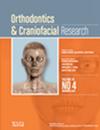Biomechanics of clear aligner therapy: Assessing the influence of tooth position and flat trimline height in translational movements
Abstract
Objective
The present clear aligner therapy (CAT) research focuses on isolating and reporting the biomechanical performance for three separate teeth, three translational movements and two flat trimlines at different heights. By identifying key patterns, the research seeks to inform the development of improved aligner designs, ultimately enhancing the effectiveness of clinical orthodontic treatments.
Materials and Methods
In an in vitro setting using the Orthodontic Force Simulator (OFS), the biomechanical response of 30 aligners was investigated on three different teeth of a straight symmetric maxillary dentition (central incisor, canine and first molar). Each tooth was tested under two flat trimline conditions (trimmed at gingival margin, TL0; extended 2.0 mm below, TL2) and for three types of translational movements (palatal translation, mesial translation and intrusion). Forces and moments were reported at the centre of resistance for each displaced tooth as well as the two neighbouring teeth, evaluating a total of 18 distinct scenarios.
Results
Findings indicate significant variability in the biomechanical responses based on tooth location in the arch, trimline height and movement performed. For palatal translations, the palatal force required to perform the movement was observed highest in molar cases, followed by canine and incisor cases, with a notable difference in the distribution of side effects, indicating a strong influence of tooth anatomy and position in the arch. Similarly, in mesial translations and intrusions molars experienced greater forces and moments than the corresponding movements applied on canines and incisors, but uniquely dispersed for each configuration tested. Regarding the shape of the aligner, TL2 consistently showed improved control over orthodontic movements compared to TL0. Neighbouring teeth frequently displayed compensatory reactions up to about half of the intensity observed on the tooth being moved, with notable variations from case to case.
Conclusions
- Characteristic patterns in the direction and intensity of forces and moments are associated with each of the three translational movements tested.
- Tooth anatomy and arch location significantly influence the biomechanical performance of aligners, with an observed trend for molars to display higher forces and moments over canines and incisors, but distributed differently.
- The height of a flat trimline, specifically TL2, shows enhanced control over orthodontic movements.
- Additional findings revealed a compensatory activity of neighbouring teeth, which varies based on tooth region and movement type. It potentially could influence CAT outcomes negatively and merits attention in future investigations.
These results support a tailored CAT method that improves aligner design for better force application. This method needs to be used alongside, and confirmed by, clinical knowledge. Future research should extend these findings to a wider range of clinical conditions for greater applicability in the day-to-day orthodontic practice.


 求助内容:
求助内容: 应助结果提醒方式:
应助结果提醒方式:


